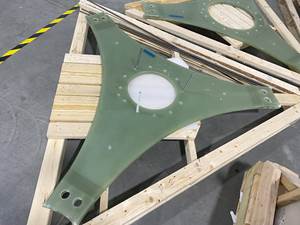Winners announced for California offshore wind energy auction
First offshore wind lease sale in the Pacific results in more than $757 million in winning bids for five lease areas in the U.S., adding to the Carolinas and New York Bight.
Provisional winners, high bids and auction area. Photo Credit: Bureau of Ocean Energy Management (BOEM)
On Dec. 7, the (Washington, D.C., U.S.) announced results from the ’s (BOEM) wind energy auction for five leases offshore California. The lease sale represents the third major offshore wind lease sale this year (see “U.S. administration announces offshore wind energy auction for the Carolinas”) and the first ever for the Pacific region. The sale drew competitive high bids from five companies totaling $757.1 million, well exceeding the first lease sales that were held in the Atlantic.
“The U.S. administration believes that to address the climate crisis head on, we must unleash a new era of clean, reliable energy that serves every household in America. This lease sale is further proof that industry momentum — including for floating offshore wind development — is undeniable,” Secretary Deb Haaland says. “A sustainable, clean energy future is within our grasp and the Interior Department is doing everything we can to ensure that American communities nationwide benefit.”
The interest and success of the sale represents a significant milestone toward achieving the president’s goal of deploying 30 gigawatts (GW) of offshore wind energy capacity by 2030 and 15 GW of floating offshore wind capacity by 2035.
“The innovative bidding credits in the California auction will result in tangible investments for the floating offshore wind workforce and supply chain in the U.S., and benefits to Tribes, communities and ocean users potentially affected by future offshore wind activities. This auction commits substantial investment to support economic growth from floating offshore wind energy development — including the jobs that come with it,” BOEM director Amanda Lefton adds.
BOEM’s lease sale offered five lease areas covering 373,268 total acres off central and northern California. The leased areas have the potential to produce more than 4.6 GW of offshore wind energy, enough to power more than 1.5 million homes.
Provisional winners include:
- RWE Offshore Wind Holdings LLC
- Lease area: OCS-P 0561, 63,338 acres
- High bid: $157.7 million
- California North Floating LLC
- Lease area: OCS-P 0562, 69,031 acres
- High bid: $173.8 million
- Equinor Wind US LLC
- Lease area: OCS-P 0563, 80,062 acres
- High bid: $130 million
- Central California Offshore Wind LLC
- Lease area: OCS-P 0564, 80,418 acres
- High bid: $150.3 million
- Invenergy California Offshore LLC 
- Lease area: OCS-P 0565, 80,418 acres
- High bid: $145.3 million
The lease sale included a 20% credit for bidders who committed to a monetary contribution to programs or initiatives that support workforce training programs for the floating offshore wind industry, the development of a U.S. domestic supply chain for the floating offshore wind energy industry or both. This credit will result in more than $117 million in investments for these critical programs or initiatives.
The auction also included 5% credits for bidders who committed to entering community benefit agreements (CBAs). The first type of agreement is a Lease Area Use CBA with communities, stakeholder groups or Tribal entities whose use of the lease areas or use of the resources harvested from the lease areas is expected to be impacted by offshore wind development. The second type of agreement is a General CBA with communities, Tribes or stakeholder groups that are expected to be affected by the potential impacts on the marine, coastal or human environment from lease development.
Under stipulations in the leases, lessees are required to engage with Tribes, ocean users and local communities that may be affected by their lease activities. Lessee engagement must allow for early and active information sharing, focused discussion of potential issues and collaborative identification of solutions. These communication and engagement activities must be routinely reported to BOEM. These lease stipulations are intended to promote offshore wind energy development in a way that coexists with other ocean uses, addresses potential impacts and benefits and protects the ocean environment, while also facilitating our nation’s energy future for generations to come.
More information about the sale, including requirements regarding the bidding credits, can be found on the .
Related Content
Composite bipolar plates provide 81% improvement to hydrogen fuel cell power density
Ultra-thin CFRTP plates developed by Hycco achieve a 7.5 kilowatt/kilogram power density, high durability for fuel cells in long-flight drone and heavy-mobility applications.
Read MoreCeramic matrix composites: Faster, cheaper, higher temperature
New players proliferate, increasing CMC materials and manufacturing capacity, novel processes and automation to meet demand for higher part volumes and performance.
Read MoreComposites end markets: Batteries and fuel cells (2024)
As the number of battery and fuel cell electric vehicles (EVs) grows, so do the opportunities for composites in battery enclosures and components for fuel cells.
Read MoreRTM, dry braided fabric enable faster, cost-effective manufacture for hydrokinetic turbine components
Switching from prepreg to RTM led to significant time and cost savings for the manufacture of fiberglass struts and complex carbon fiber composite foils that power ORPC’s RivGen systems.
Read MoreRead Next
Ultrasonic welding for in-space manufacturing of CFRTP
Agile Ultrasonics and NASA trial robotic-compatible carbon fiber-reinforced thermoplastic ultrasonic welding technology for space structures.
Read MoreNext-gen fan blades: Hybrid twin RTM, printed sensors, laser shock disassembly
MORPHO project demonstrates blade with 20% faster RTM cure cycle, uses AI-based monitoring for improved maintenance/life cycle management and proves laser shock disassembly for recycling.
Read MoreCeramic matrix composites: Faster, cheaper, higher temperature
New players proliferate, increasing CMC materials and manufacturing capacity, novel processes and automation to meet demand for higher part volumes and performance.
Read More












